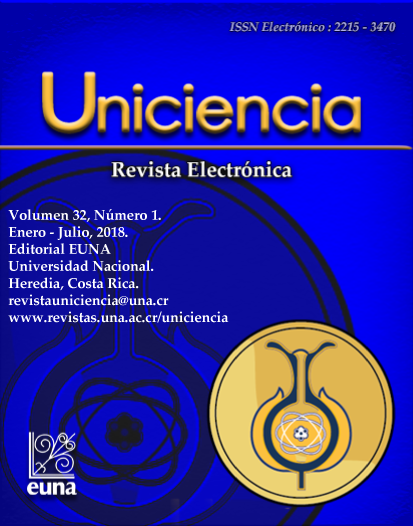Estimación de costo de software: Una propuesta de aplicación pedagógica de COCOMO
DOI:
https://doi.org/10.15359/ru.32-1.8Palabras clave:
COCOMO básico, COCOMO intermedio, estimación de costos del software, ingeniería de software, propuesta pedagógica de enseñanza de COCOMOResumen
Los planes de estudio de ciencias de la computación y carreras afines evidencian una brecha importante en torno a la temática de estimación de costos de proyectos de software. En general, en los modelos curriculares relacionados con el desarrollo de software, se recomienda la temática de la estimación en el desarrollo del software sin especificar ningún modelo de estimación en concreto. En abono a lo anterior, dichos modelos tienen la particularidad de que son difíciles de entender y los ejemplos existentes en la bibliografía suelen ser muy vagos sin considerar contextos cercanos a la realidad. En este artículo se presenta una propuesta de aplicación pedagógica del modelo de estimación de costos COCOMO en las modalidades básica e intermedia orientada a la magnitud del producto final. El modelo incluye seis apartados necesarios para un adecuado abordaje pedagógico. Lo primero que se define es su fundamento teórico esquematizado de forma resumida. Además, se presenta un caso real de estudio, ejemplos resueltos, la propuesta pedagógica y el análisis respectivo. La relevancia de este trabajo se fundamenta en el hecho de que se facilita la enseñanza del tema de estimación del costo del software, de forma práctica y contextualizada en un caso real.
Referencias
Basavaraj, M. J., y Shet, K. C. (2008). Empirical validation of Software development effort multipliers of Intermediate COCOMO Model. Journal of Software, 3(5), 65-71. Recuperado de http://www.jsoftware.us/show-60-641-1.html
Boehm, B. (1981). Software engineering economics. Vol. 197. Recuperado de http://csse.usc.edu/TECHRPTS/1984/usccse84-500/usccse84-500.pdf
Boehm, B., Abts, C., y Chulani, S. (2000). Software development cost estimation approaches—A survey. Annals of software engineering, 10(1), 177-205. doi: https://doi.org/10.1023/A:1018991717352
Cassel, L., Clements, A., Davies, G., Guzdial, M., McCauley, R., McGettrick, A., Sloan B., Snyder L., Tymann, P., y Weide, B. (2008). Computer science curriculum 2008: An interim revision of CS 2001. Recuperado de https://www.acm.org/education/curricula/ComputerScience2008.pdf
Dabbagh, N. (2005). Pedagogical models for E-Learning: A theory-based design framework. International Journal of Technology in Teaching and Learning, 1(1), 25-44. Recuperado de http://sicet.org/web/journals/ijttl/issue0501/DabbaghVol1.Iss1.pp25-44.pdf
Doering, A., y Veletsianos, G. (2008). Hybrid online education: Identifying integration models using adventure learning. Journal of Research on Technology in Education, 41(1), 23-41. doi: https://doi.org/10.1080/15391523.2008.10782521
Garita, G. (2014). Métodos analíticos y métricas de calidad del software. San José. Costa Rica: Editorial EUNED.
Gorgone, J., Gray, P., Stohr, A., Valacich, J., y Wigand, R. (2006). MSIS 2006: model curriculum and guidelines for graduate degree programs in information systems. ACM SIGCSE Bulletin, 38(2), 121-196. doi: https://doi.org/10.1145/1138403.1138448
Hernández, R., Fernández-Collado, P., Baptista, L. (2006). Metodología de la investigación. México: Mc. Graw Hill.
Kemerer, C. (1987). An empirical validation of software cost estimation models. Communications of the ACM, 30(5), 416-429. doi: https://doi.org/10.1145/22899.22906
LeBlanc, J., Sobel, A., Diaz-Herrera, L., y Hilburn, B. (2006). Software Engineering 2004: Curriculum Guidelines for Undergraduate Degree Programs in Software Engineering. Miami: IEEE Computer Society.
Leung, H., & Fan, Z. (2012). Software Cost Estimation. In Handbook of Software Engineering and Knowledge Engineering (pp. 307-324). World Scientific Publishing Company. Recuperado de https://doi.org/10.1142/9789812389701_0014
Lewis, J. (2001). Limits to software estimation. ACM SIGSOFT Software Engineering Notes, 26(4), 54-59. doi: https://doi.org/10.1145/505482.505490
McDonald, J. (2001). Why is software project management difficult? And what that implies for teaching software project management. Computer Science Education, 11(1), 55-71. doi: https://doi.org/10.1076/csed.11.1.55.3845
Mehmood, Z., y Saeed, S. (2009). Teaching quality assurance and project management to undergraduate computing students in Pakistan. Recuperado de http://www.academia.edu/19786065/Teaching_Quality_Assurance_and_Project_Management_to_Undergraduate_Computing_Students_In_Pakistan
Pyster, Art. (2009). Graduate Software Engineering 2009 (GSwE2009) Curriculum Guidelines for Graduate Degree Programs in Software Engineering. Stevens Institute of Technology. Recuperado de https://www.acm.org/binaries/content/assets/education/gsew2009.pdf
Sharma, H. K. (2013). E-COCOMO: The Extended COst Constructive MOdel for Cleanroom Software Engineering. Database Systems Journal, 4(4). 3-11. Recuperado de http://www.dbjournal.ro/archive/14/14_1.pdf
Topi, H., Valacich, J., Wright, R., Kaiser, K., Nunamaker, J., Sipior, J., de Vreede, G. (2010). IS 2010 Curriculum Guidelines for Undergraduate Degree Programs in Information Systems. Association for Computing Machinery (ACM) & Association for Information Systems (AIS). Recuperado de https://www.acm.org/education/curricula/IS%202010%20ACM%20final.pdf
Yang, D., Wang, Q., Li, M., Yang, Y., Ye, K. y Du, J. (2008). A survey on software cost estimation in the chinese software industry. Proceedings of the Second ACM-IEEE international symposium on Empirical software engineering and measurement. ACM. doi: https://doi.org/10.1145/1414004.1414045
Publicado
Número
Sección
Licencia
Los autores que publican en esta revista están de acuerdo con los siguientes términos:
1. Los autores garantizan a la revista el derecho de ser la primera publicación del trabajo al igual que licenciado bajo una Creative Commons Attribution License que permite a otros compartir el trabajo con un reconocimiento de la autoría del trabajo y la publicación inicial en esta revista.
2. Los autores pueden establecer por separado acuerdos adicionales para la distribución no exclusiva de la versión de la obra publicada en la revista (por ejemplo, situarlo en un repositorio institucional o publicarlo en un libro), con un reconocimiento de su publicación inicial en esta revista.
3. Los autores han afirmado poseer todos los permisos para usar los recursos que utilizaron en el artículo (imágenes, tablas, entre otros) y asumen la responsabilidad total por daños a terceros.
4. Las opiniones expresadas en el artículo son responsabilidad de los autores y no necesariamente representan la opinión de los editores ni de la Universidad Nacional.
Revista Uniciencia y todas sus producciones se encuentran bajo una Licencia Creative Commons Atribución-NoComercial-SinDerivadas 4.0 Unported.
No existe costo por acceso, revisión de propuestas ni publicación para autores y lectores.







